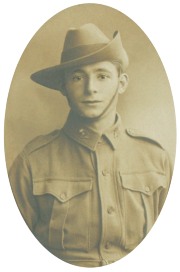Melbourne Tram Museum
- Follow Melbourne Tram Museum on Twitter
- Follow Melbourne Tram Museum on Facebook
- Follow Melbourne Tram Museum on Instagram
- Follow Melbourne Tram Museum on Pinterest
- Follow Melbourne Tram Museum on Tumblr
- Subscribe to Melbourne Tram Museum's RSS feed
- Email Melbourne Tram Museum
Tramway ANZAC: Robert Avenel Bennet
Bravery on the Western Front
On 4 August 1914, Britain declared war on Germany and Australia, as a dominion of the British Empire, followed suit. Less than two weeks after the declaration of war, tram conductor Robert Avenel Bennet volunteered for military service. He was one of many thousands of ordinary Australian men that went on to perform extraordinary acts of bravery during the First World War.
Born in Avenel, Victoria, in 1888, Robert was the fourth of six siblings. The young family never settled permanently, with the parents following employment opportunities at various hospitals. Robert’s father, Manchester-born Norman Francis Bennet, was a pharmacist and hospital dispenser, and his mother, Agnes, was a nurse. Just after their marriage in West Melbourne in 1883, Norman started work at Clunes Hospital, where Agnes was appointed as matron. The family moved back to Melbourne for a few months before heading west to Nhill Hospital, with Norman and Agnes appointed to the same positions as at Clunes. In 1893 Norman became Superintendent and dispenser at Wilcannia Hospital, but Agnes and the children came back to Melbourne followed by another move to Korumburra where Agnes worked as a nurse. By 1909 Agnes had returned to Melbourne.
In 1913 Robert was 25 years old and working as a conductor for the Prahran & Malvern Tramways Trust (PMTT), the largest of the six municipal electric tramway trusts in Melbourne. The following year he married Nellie May Cardwell, the couple living in Heath Street, Port Melbourne.
And then, on 17 August 1914, Robert enlisted for service in the Australian Imperial Force.
A month later, he embarked from Melbourne, as a gunner with 2 Field Artillery Brigade. Unlike many volunteers who had served with the Militia under the Universal Service Scheme – the compulsory military training introduced in Australia in 1911 – Robert had no military experience, suggesting he had been eligible for an exemption.
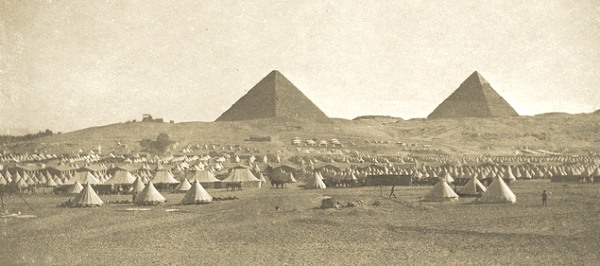
Mena camp, Egypt, looking towards the Pyramids, 28 February 1915. This is where 2 Field Artillery Brigade conducted training before embarking for Gallipoli.- Photograph courtesy of Australian War Memorial (H04206).
After training in Egypt, Robert served at Gallipoli. In July 1915 he was taken on strength of the Heavy Battery from 2 Brigade Ammunition Column. Two months later he was promoted to Temporary Bombardier and then in October to Temporary Corporal. Robert returned to Egypt in December 1915.
During his absence, Robert had become a father – Nellie gave birth to a daughter in 1915.
A rapid succession of promotions followed. Temporary Sergeant in April 1916, followed a month later – after attending the Imperial School of Instruction at Zeitoun, Egypt – with a commission as a 2nd Lieutenant together with a transfer to 13 Field Artillery Brigade (5th Division).
The Zeitoun school ran classes for officers and non-commissioned officers from British Empire forces. Topics included artillery warfare, Lewis guns, Vickers machine guns and Stokes mortars, as well as signal and telephone operations.
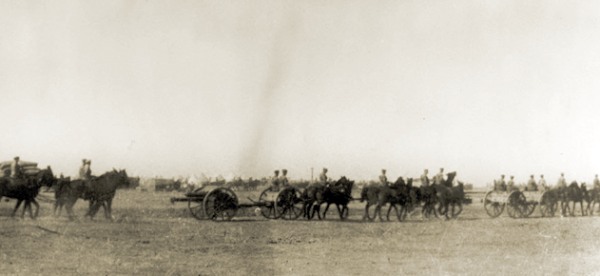
An 18-pounder Battery returning from general inspection, Tel el Kebir, Egypt, January 1916. The 13 Field Artillery Brigade was formed at Tel el Kebir in February 1916.- Photograph courtesy of Australian War Memorial (C04136).
Robert was then taken on strength of 5 Divisional Ammunition Column, and in June 1916 he embarked for Marseilles, the first stage on the journey to the Western Front. In August 1916 he was promoted to Lieutenant and two months later transferred back to 13 Field Artillery Brigade and was posted to the Brigade’s 51st Battery.
From June 1916 13 Field Artillery Brigade provided support to 5th Division for a number of actions on the Western Front, including the disastrous attack at Fromelles in July 1916. Equipped with 18-pounder field guns, with a range of around 6500 yards (about 6km), field artillery brigades were key unit types on the Western Front, the combination of artillery bombardment and weather creating the muddy quagmire that became synonymous with that campaign.
The Third Battle of Ypres spanned the period July to November 1917, with extensive involvement by Australian troops, including 5th Division. The original aim of the British command was to penetrate heavily-fortified German-held territory to the south and east of the Belgian city of Ypres and eventually progress through to the German submarine bases on the Belgian coast. However the individual offensives proved to be extremely costly for limited gain.
According to the Australian War Memorial:
Bennet was awarded the Military Cross for conspicuous bravery and devotion to duty near Westhoek when the 5th Australian Divisional Artillery sent its forward batteries, one gun at a time, to support the Scottish infantry of the British Fifth Army in their advance to the German Second Line, passing the old front line area at Cambridge Road near the Ypres-Roulers railway. Heavy shell fire delayed the parties making a track across No Man’s land for the guns so Bennet reconnoitred his own route and brought his gun into action at 11.36 am. After the Scots were forced to fall back Bennet was ordered to withdraw his gun. After three attempts in heavy rain during which all but two members of his detachment were killed or wounded Bennet retired without the gun. He returned and successfully retrieved it on 2 August.
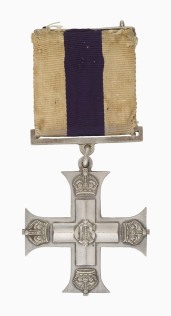 Military Cross: Lieutenant R.A. Bennet, 51 Battery, 13 Field Brigade,
AIF.
Military Cross: Lieutenant R.A. Bennet, 51 Battery, 13 Field Brigade,
AIF. - From the collection of the Australian War Memorial (REL/06076.001).
The recommendation for the award of the Military Cross describes Robert’s actions in more detail:
On 31st. July 1917, Lieut. R.A. BENNET, 13th. Aust.F.A.Bde. was detailed to follow the Infantry in an advance with one gun.
On reaching the old front line trenches there was no track by which the gun could be moved across. Lieut. BENNET immediately made a reconnaissance, crossing 4 times through the hostile barrage and having found the most suitable point, succeeded in collecting 2 separate working parties and making a track across. The whole operation was carried out under intense and accurate hostile shelling and the latter portion under heavy and continuous rifle and machine gun fire in addition. All the detachment except two became casualties. Lieut. BENNET nevertheless brought his gun into action at I 6 b29. at 2.p.m.
This officer succeeded by the very greatest coolness, initiative and perseverance in accomplishing his task.
Fellow officers and men who served with Robert described him as “a splendid man”, “very popular and very well-liked by all the men in the Battery”.
By August it became apparent that British command’s original objective would not be realised, nonetheless the commander of the British forces, Field Marshall Douglas Haig, maintained the offensives, aiming to weaken the German forces through attrition despite the huge casualties incurred by the Allied forces.
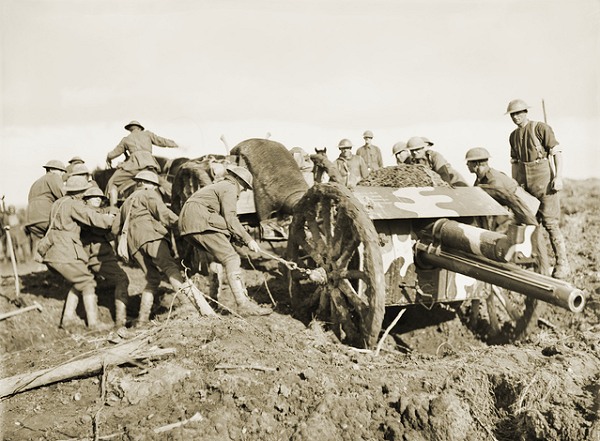
An 18-pounder field gun being hauled through the mud at Broodseinde Ridge to a position further forward in support of the advancing Australians, October 1917.- Photograph courtesy of Australian War Memorial (E01208).
The offensive of 4 October 1917, known as the Battle of Broodseinde Ridge, involved twelve divisions. As in the previous offensives of the Third Battle of Ypres, a massive artillery bombardment preceded the advance of the troops, who were to achieve and consolidate defined positions. Robert’s battery was in action at Broodseinde Ridge. At 6:04am, while controlling the fire of his battery, he was killed instantly by a piece of shrapnel from a high explosive shell.
Two officers and nine men from 13 Field Artillery Brigade were killed on that day. The unit diary notes that the loss of Lt Bennet and Lt McMullin was a huge blow to the brigade, both having provided excellent service.
Robert was just 29 years old. He is buried at The Huts Cemetery, West-Vlaanderen, Belgium.
His Military Cross and service medals are in the collection of the Australian War Memorial. Robert is also commemorated on both the PMTT and the M&MTB honour rolls.
From the poignant letters in Robert’s service file, his wife Nellie was desperate for information about her husband. After his death, Nellie asked if she could wear his ribbons in remembrance – however medals and ribbons are only permitted to be worn by the recipient. Nellie remarried in 1922 and gave birth to another daughter.
Robert never saw his daughter, Nancy Lorraine Cairo Bennet. She lived to a great age, passing away in 2000.
Bibliography
Australian Imperial Force Unit War Diaries (1914-1918), 13th Australian Field Artillery Brigade - October 1917
Australian Red Cross Society (1914-1918), Wounded and Missing Enquiry Bureau Files – Lieutenant Robert Avenel Bennet, 13th Field Artillery Brigade
Australian War Memorial, Battle of Broodseinde Ridge
Australian War Memorial, Military Cross: Lieutenant R A Bennet, 51 Battery, 13 Field Artillery Brigade, AIF
National Archives of Australia (1914-1918), Robert Avenel Bennet – Service Record
Public Record Office Victoria, Divorce Case Files, 1860-1940, VPRS 283
